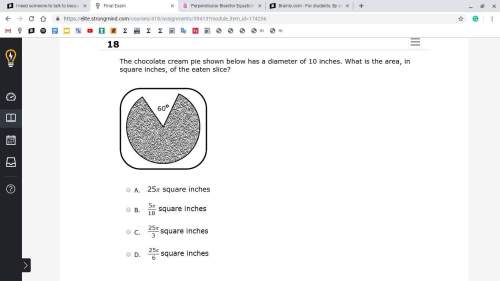
Mathematics, 20.09.2020 16:01 jv910699
Construct a line segment or an angle—it's your choice! Then, bisect the segment or angle you constructed. Think about the steps you took to construct and bisect the line segment or angle. If you chose a line segment, how are the construction steps you completed similar to the steps you would have taken to construct and bisect an angle? How are they different? If you chose an angle, how are the construction steps you completed similar to the steps you would have taken to construct and bisect a line segment? How are they different?

Answers: 2


Other questions on the subject: Mathematics

Mathematics, 21.06.2019 17:00, deniseelyons15
Yosef can eat 21 jamuns while rose can eat just 15 . complete the blank. yosef can eat % more jamuns than rose.
Answers: 1

Mathematics, 21.06.2019 23:00, lizbethmillanvazquez
Apackage of orgainc strwberries costs $1.50 while there in season and $2.25 when not in season what the percent increase
Answers: 1

Mathematics, 22.06.2019 02:00, darianhaynes
Study published in the journal of personality and individual differences found that adults with adhd displayed more creative achievement than those who didn't have the disorder. "for the same reason that adhd might create problems, like distraction, it can also allow an openness to new ideas," says holly white, assistant professor of cognitive psychology. "not being completely focused on a task lets the mind make associations that might not have happened otherwise." white and priti shah at the university of michigan gave 60 college students – half of them with adhd – a series of tests measuring creativity across 10 domains. the adhd group scored higher across the board. the adhd group showed more of a preference for brainstorming and generating ideas than the non-adhd group, which preferred refining and clarifying ideas. the adhd status of the participants was established by asking whether the individual had ever been clinically diagnosed with adhd/add. the tests of creativity were pencil-and-paper tasks administered in a laboratory setting. each of the ten scales was comprised of multiple questions, the scores on which were summed (e. g., writing creativity: "how many words can you make from the letters in the word 'psychology' invention creativity: "write down as many uses for a paper clip that you can think of.") this procedure does allow for a participant to be scored as showing no creativity under these conditions. a) state the research question in plain language (i wonder if is related to (1 point) b) state the null hypothesis (1 point) c) state the research hypothesis (1 point) d) is the research hypothesis directional or non-directional (1 point) e) name the predictor / independent variable f) give the operational definition of the predictor / independent variable g) evaluate the construct validity of the predictor / independent variable. (face, procedure, method-match) h) name the outcome / dependent variable i) give the operational definition of the outcome / dependent variable. j) evaluate the construct validity of the outcome / dependent variable. (face, procedure, method-match)
Answers: 1
You know the right answer?
Construct a line segment or an angle—it's your choice! Then, bisect the segment or angle you constru...
Questions in other subjects:






Mathematics, 23.09.2019 23:30




Mathematics, 23.09.2019 23:30




